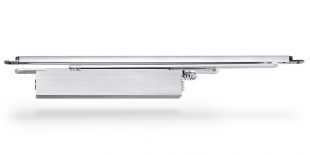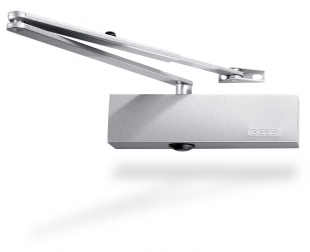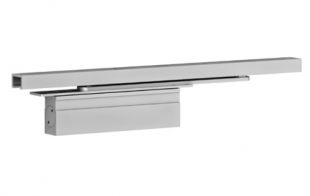Here are some commonly asked questions and answers related to door closers.
What are the Three Fitting Methods?
There are 3 different methods to fixing door closers. Firstly, Figure 1 fixing (pull side or hinge side), this is the most common method, where the door closer is fixed to the hinge side of the door, the door closer is attached to the door and the closer arm is attached above the door frame. The second method of fitting a door closer is Figure 61 fixing (push side or opposite hinge side), with this method the door closer is attached to the frame of the door, and the arm is attached to the door on the opposite hinge side. For these two methods, a standard ‘hinge side’ door closer and arm are required. The last method of fixing is Figure 66 fixing (push side or opposite hinge side) where you will require an ‘opposite hinge side’ guiderail door closer or for a scissor arm, you would need to use the parallel arm bracket included in the kit. For this method, the door closer is attached to the door and the parallel arm bracket is fitted underneath the door frame head. The arm is then attached to the parallel arm bracket, on the opposite hinge side. For a more in-depth fitting tutorial, see our YouTube video; https://www.youtube.com/watch?v=dcsndLNJREw
What Tools do I Need to Fit a Door Closer?
The tools you will need to fit a door closer include a drill and drill bits (3.5mm for wood and 5.1mm for metal), a pencil, so you can easily mark out where you are going to be putting the door closer, a hammer, a centre punch, a screwdriver, socket wrenches and a cloth or a rag.
How Much Skill do I Need to Fit a Door Closer?
In order to be able to fit a door closer, you will need some DIY experience and the appropriate materials. Fitting a door closer is not recommended for a first time DIYer, but with a good level of experience, fitting a door closer should not be too difficult. Every door closer comes with a paper template, in which you can easily mark out where the holes will need to be drilled.
Can I Adjust a Door Closer?
Yes, you can adjust a door closer. It is easy to adjust a door closer with just a ladder and a screwdriver, hex key or small wrench, NOT an electric screwdriver. You will just need to make small turns (about 20 degrees) in one of the adjustment screws, this should allow the door closing speed, the door latching speed and the door delay to be altered. Clockwise turns should slow it down, and anti-clockwise turns should speed up the closing speed. For more information on adjusting door closers, see our YouTube video; https://www.youtube.com/watch?v=dcsndLNJREw
What are the Different Types of Door Closers?



There are 3 different types of door closers, so all types have different features. Scissor arm door closers allow movement of up to 180 degrees, they can be fitted as a figure 1, figure 61 and figure 66 fixing (see fitting methods question or the guide available on our website; https://www.doorstuff.co.uk/p/fixing-positions https://www.doorstuff.co.uk/p/fixing-positions-guide-rail ) these door closers are more prone to vandalism so are less appropriate for setting such as schools, etc. where they can be swung on. Guide rail door closers allow movement of up to 120 degrees, which is less than a scissor arm, but they are better for places such as schools as they are flat to the door and there is nothing which you can pull or hang on without the arm detaching. Finally, concealed door closers are completely hidden and cannot be seen from the outside of a door, however, they must be fitted by an experienced carpenter, because they are much more complex.
For any more questions you may have in relation to door closers don’t hesitate to comment on this blog post, or contact us at info@doorstuff.co.uk and we will get back to you.
